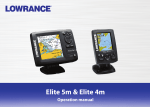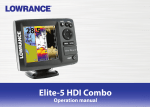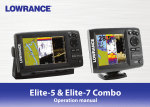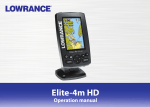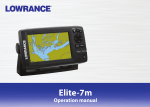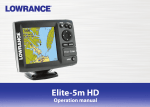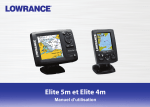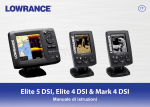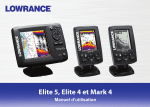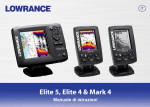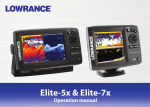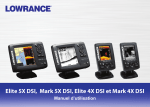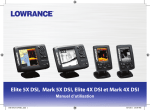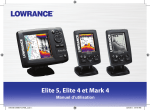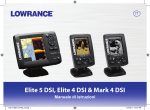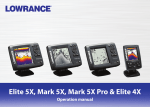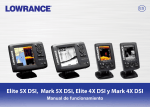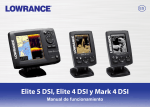Download Operation Manual
Transcript
5, Elite 4 & Mark 4 Installation &Elite Operation Operation manual manual Copyright © 2011 Navico All rights reserved. Lowrance® and Navico® are registered trademarks of Navico. Fishing Hot Spots® is a registered trademark of Fishing Hot Spots Inc. Navionics® is a registered trademark of Navionics, Inc. Navico may find it necessary to change or end our policies, regulations and special offers at any time. We reserve the right to do so without notice. All features and specifications subject to change without notice. Visit our website: www.lowrance.com Table of Contents Introduction....................................... 3 Advanced Mode .................................... 10 Unit Controls............................................. 3 Standby mode........................................ 10 Inserting microSD cards........................... 4 Restore defaults..................................... 10 Setup wizard............................................. 5 Adjusting the display.............................. 10 Basic Operation................................ 5 Pages................................................11 Selecting Pages....................................... 5 Steer Page............................................. 11 Page menus............................................. 6 Sonar Page............................................ 11 Working with menus................................. 7 Chart/Sonar page .................................. 12 Dialogs..................................................... 8 Chart Page............................................. 12 Entering text............................................. 8 Overlay Data.......................................... 13 Fishing Modes.......................................... 8 Chart/Sonar split..................................... 13 Cursor....................................................... 9 Using your Sonar............................ 15 Goto cursor............................................... 9 Trackback............................................... 15 1 Table of Contents Sonar Menu............................................ 15 System................................................... 30 Sensitivity............................................... 16 Saving Screenshots............................... 32 Colorline/Grayscale................................ 17 Navigation.............................................. 33 Depth Range.......................................... 17 Chart....................................................... 34 Frequency ............................................. 18 Sonar ..................................................... 36 Ping Speed (Advanced Mode only)........ 18 Installation.............................................. 37 Fish ID.................................................... 20 Alarms ................................................... 38 Using your Chart............................ 21 Index................................................ 40 Chart Menu............................................. 21 Specifications................................. 42 Waypoints, Routes, Trails....................... 22 Routes Screen........................................ 23 Trails Screen.......................................... 27 Orientation.............................................. 29 Settings........................................... 30 2 Introduction Unit Controls Getting Started LIGHT/POWER: controls backlight level and turns unit on/off KEYPAD: controls cursor & selects items on menus PAGES: allows you to select a page to view MENU: opens settings, context and page menus ENTER: finalizes menu selections; save waypoint at cursor position MOB: press and hold both Zoom keys to create a Man Overboard waypoint ZOOM Keys: used to zoom in/zoom out microSD slot: insert a blank microSD card to save screen captures; or insert a microSD mapping card to use mapping data (See illustration on page 2) Turn unit on/off To turn on/off the unit, press and hold the Light/Power key for three seconds. Man Overboard waypoint Press the zoom in and zoom out keys at the same time to set a Man Overboard waypoint. Your system will automatically create an active route back to the MOB waypoint. You must cancel navigation to terminate the function. Adjusting the backlight This unit has 10 backlight levels. Press the Light/Power key to switch backlight levels. Muting Audio Select Mute Audio from the System menu and press Enter. Selecting a GPS Source 3 Select GPS Source from the System menu and press Enter. Select internal or external and press Enter. (Elite-5 only) Introduction Inserting microSD cards Carefully slide the microSD card into the slot until it clicks into place. To remove, carefully push in the card until it clicks out of place. 4 Basic Operation Setup wizard Pages The Setup wizard will appear when the unit is turned on for the first time. To choose your own settings, do not run the setup wizard. This unit has four pages: Sonar, Chart, Sonar/Chart and Steer. To restart the Setup wizard, restore defaults. Selecting Pages NOTICE Pages menu To select a page, press the keypad in the direction of the desired page. This manual covers several units. Some screenshots may differ from what you see on your screen. Your unit, however, will function in a similar manner. 5 Basic Operation Sonar page Sonar menu Page menus The Steer, Sonar, Chart/Sonar and Chart pages have menus that can only be accessed when those pages are displayed. Chart/Sonar page Chart or sonar menu will appear depending on which panel is active. Press the Pages key twice to switch active panels. Steer menu Steer page Chart menu Chart page 6 Basic Operation Accessing the Settings menu Scrollbars Select the scrollbar and press the keypad left (decrease) or right (increase). On/Off features Accessing menu items Select an on/off menu item and press Enter to turn it on/off. The keypad and enter key are used to select menu items and open submenus. Use the keypad to highlight the desired item and press Enter. Dropdown menus After accessing the dropdown menu, press the keypad up/down to select the desired item and press Enter. Working with menus There are several menu types used to make adjustments to options and settings, including scrollbars, on/off features and dropdown menus. NOTE: Press the Menu key to Exit menus. 7 Basic Operation Dialogs To input text: Dialogs are used for user input or for presenting information to the user. 1. U se the keypad to select the desired character and press enter. Depending on the type of information or entry, different methods are used to confirm, cancel or close the dialog. 3. W hen entry is completed, highlight OK and press enter. 2. Repeat Step 1 for each character. Fishing Modes Entering text Fishing modes enhance the performance of your unit by providing preset packages of sonar settings geared to specific fishing conditions. Some functions, like naming a waypoint, route or trail, will require you to input text. Switches letters to uppercase/ lowercase Switches keyboard between Alpha and QWERTY layout 8 Basic Operation Cursor Fishing Mode Options General Use Bottom brown/white background; 50% ping speed Shallow Water Bottom brown/white background; best for depths less than 100 feet Fresh Water Bottom brown/white background; 50% ping speed Deep Water Deep Blue; 50% ping speed; 50kHz is primary transducer frequency Slow Trolling Bottom brown/white background; 50% ping speed Fast Trolling Bottom brown/white background; slightly lower chart speed Clear Water Bottom brown/white background; 50% ping speed Brackish Water Bottom brown/blue background; higher ASP; slightly lower chart speed The keypad moves the cursor around the display, allowing you to scroll the map, select map items and review sonar history. Press Menu and select Return to vessel or Exit cursor mode to clear the cursor. Goto cursor Allows you to navigate to the cursor. 1. M ove the cursor to a desired location and press Menu. 2. Select Goto cursor and press Enter. NOTE: Use Fresh Water mode when fishing in less than 100 feet of water; otherwise your unit may not track bottom properly. 9 Basic Operation Advanced Mode Enables advanced features and settings. The following features are enabled when Advanced mode is turned on: Press the PWR/Light key to access the Backlight dialog. Select Standby and press Enter. Press any key to resume normal operation. NOTE: Leaving your unit in Standby mode when your boat is not is use will run down your battery. • Colorline (manual control) • Surface Clarity (manual control) • Ping Rate (manual control) • larms (Enables arrival, off course and A anchor alarm options) Restore defaults • NMEA 0183 Output • nits (Enables distance, speed, depth, U temperature, and bearings options) Resets unit options and settings to defaults. Adjusting the display Standby mode Lowers power consumption by turning off sonar and the display. You can make adjustments to the display using Sensitivity, Colorline and Palettes. Those features are covered in the Sonar section. 10 Pages Direction to Current Track waypoint Your location Compass Overlay Data Surface Clutter Colorline Fish arches Cursor Range Scale Navigation Location and depth Depth information Frequency Amplitude Scope Steer Page The Steer page has a compass that shows your current track, the direction to your destination, and a digital data navigation panel. Sonar Page Displays the water column moving from right to left on your unit’s screen. On the right side of the screen, the Amplitude Scope bar previews echoes about to appear on the display. 11 Pages Depth contours Chart/Sonar Page Current location; distance to cursor Current location Waypoint Zoom Range Chart/Sonar page Chart Page Consists of a chart/sonar splitscreen. Press the Pages key twice to switch active panels. The active panel will have an orange border. Consists of map that moves in real-time as you move. By default, the map is shown from a birdseye view with North at the top of the screen. 12 Pages Chart/Sonar split Overlay Data Allows you to change the way the panels are displayed when viewing the Chart/Sonar page. Displays selected overlay data on the sonar page. Show Press the Pages key twice to switch active panels. Overlay data Enables/disables the display of overlay data, allowing you to remove overlay data from the screen without deleting the selected overlay data configuration. Configure Used to select overlay data to be displayed on the screen. 13 Pages To select overlay data: 1. F rom a sonar or chart page, press Menu. 2. Select Overlay data and press Enter. 3. Select Configure and press enter. 4. Press Menu and select Add. Press Enter. 5. S elect a category from the Configure Items to show screen. Press Enter. 6. Press Menu and select Return to overlay. Customizing Overlay Data Access the Overlay Data configuration menu to make adjustments to the size and/or location of overlay data on the display. Press Menu from the Configure Item Locations and Sizes screen to access the menu. 7. Press Menu, select Done Configuring and press Enter. 14 Sonar Using your Sonar Cursor depth Blue sonar history bar Move the blue sonar history bar all the way to the right to resume normal sonar scrolling. Press Menu and select Exit cursor mode to remove the cursor from the screen. Sonar Menu Trackback You can review your recent sonar history by moving the cursor to the left until the screen starts to move in reverse. The sonar menu has options and settings that affect the appearance of the display. 15 Sonar Press Menu from any sonar page to access the Sonar menu. New waypoint menu Adjust (Advanced Mode only) Sonar Menu Used to make adjustments to Sensitivity and Colorline/Grayscale. (Advanced Mode) Sensitivity New Waypoint Places a waypoint at your current position or at the cursor position. From the new waypoint menu, you can input a waypoint name, select an icon and input a desired latitude/longitude. Controls the level of detail shown on the display. Too much detail will clutter the screen. If Sensitivity is set too low, desired echoes may not be displayed. 16 Sonar Auto Sensitivity Keeps sensitivity at a level that works well under most conditions, reducing the needs for adjustments. Auto Sensitivity is turned on by default. Sensitivity set to 65 percent. Sensitivity set to 85 percent. NOTE: You can make minor (+/-4%) changes to sensitivity with Auto Sensitivity turned on. You will have to turn it off to make significant adjustments. Colorline/Grayscale Separates strong sonar echoes from weak sonar echoes. That makes it easier for you to distinguish fish or structure from the bottom. A hard return will be shown as a wide, bright yellow area, whereas a soft return will be a narrow reddishblue area. Mark series units have a monochrome display, so wide bands of gray indicate a hard sonar return, while softer returns are shown as dark, narrow lines. Depth Range Selects the deepest range shown on the display. Range settings display the section of the water column from the water surface to the selected depth range. If you select too shallow a depth range, the unit will not be able to lock onto the bottom. 17 Sonar Custom Range — Upper and Lower Limits (Advanced Mode only) Used to select the upper limit and lower limit of a section of the water column. That allows you to view a section of the water column that does not include the water surface. Frequency Controls the transducer frequency used by the unit. This unit supports two frequencies: 200kHz and 83kHz. Frequency menu Custom range menu Upper and lower limits must be at least 6.5 ft (2m) apart. NOTE: When using a custom range, you may not receive any digital depth readings, or you may recieve incorrect depth information. 200 kHz has the highest sensitivity and best target discrimination in shallow water. 83 kHz offers a wider cone angle for more water coverage. Ping Speed (Advanced Mode only) Controls the rate the transducer uses to send sonar waves into the water. Ping speed adjustments can help reduce interference from other transducers. When using fishing modes, ping speed settings are optimized for the selected fishing conditions, so in most cases, adjustments are not necessary. 18 Sonar Sonar Options Color Accesses sonar display settings and configuration options. Allow you to change the look of the display using palettes with varying degrees of color/brightness. Split Zoom and Split Flasher Switches the sonar display from full screen sonar to a split screen view. Nightview Iceview Monochrome units support Grayscale, Reverse Grayscale and Bottom Black. Amplitude Scope Split Zoom Split Flasher Displays the amplitude of realtime echoes before they appear on the display. 19 Amplitude scope Sonar Fish ID Overlay Data Displays fish echoes as fish symbols instead of fish arches. Fish ID is not the most accurate method of fish detection since structure and suspended debris may be shown as a fish symbol on the display. Allows you to select data (water temperature, depth, etc) to be displayed on top of the Sonar screen. Ice Mode Turns on a package of sonar settings optimized for ice fishing and also overlays battery meter data on the screen. Overlay data setup is covered Overlay data in the Pages section. Settings Accesses the Sonar settings menu. Stop Sonar Pauses the unit’s sonar, allowing you to get a closer look at suspended targets. Stop Sonar also can be used to prevent/stop interference between two units running on the same boat at the same time. 20 Chart Using your Chart This section covers chart operation, which includes saving, loading and navigating, waypoints, routes and trails and using chart menus, context menus and submenus. Chart Menu Press Menu from any Chart pages to open the Chart menu. New Waypoint Chart menu Creates a waypoint at your current location or at the cursor position. When the cursor is on the screen, waypoints will be saved at the cursor position; conversely, if the cursor is not displayed onscreen, waypoints will be saved at your current position. 21 Chart Waypoints, Routes, Trails Used to create, edit, navigate and delete waypoints, routes and trails. Press the keypad left/right to toggle between waypoint, routes and trails tabs. Waypoints menu Waypoints Screen Waypoints menu Edit Allows you to edit the name, icon and latitude/longitude. of a selected waypoint. 22 Chart New Sort Creates a new waypoint at the cursor or vessel position. You can also select waypoint name, icon and latitude/longitude from the new waypoint menu. Controls how the waypoints list will be sorted — by name or by nearest. Show Routes Screen Used to create, edit, navigate and delete routes. Use the keypad to highlight the Routes tab to access the Routes screen. Displays the selected waypoint on the map. Goto Routes screen Allows you to navigate to a waypoint. Routes menu Creating a route Delete and Delete All Delete is used to delete a selected waypoint. Delete All deletes all waypoints. Routes can be created by inserting waypoints from the waypoints list or by using the cursor to position new points on the chart. You also can add waypoints to a route by selecting them from the chart screen. 23 Chart Shows selected route waypoint on the chart Leg name field Inserts waypoint between existing route waypoints Adds waypoint to end of the route Remove waypoint Route waypoint menu Controls how waypoints are listed 4. Press Menu, select Add to End and press Enter. 5. H ighlight Waypoint from list and press Enter. 6. S elect the desired waypoint and press Enter. Starts navigation to the selected route waypoint 7. Press Menu and select Add to end to add another waypoint to the route. To create a route from waypoint list: 1. Press Menu from the Routes screen. 8. W hen the route is complete, press Menu, select Stop Editing and press Enter. 2. Select New... and press Enter. 3. P ress the keypad down to select the Leg name field and press ENTER. 9. Select Save and press Enter. 24 Chart Creating a route using points from chart: 1. R epeat Steps 1-4 from the instructions for Creating a route from waypoint list. 2. Select Points from chart and press Enter. The chart screen will appear. 3. M ove the cursor to the desired location. Press Enter to set a waypoint. 4. R epeat Step 3 to add more route waypoints. 5. Press Menu and select Stop adding. Press Enter. 6. H ighlight the Save button and press Enter. Routes menu Navigating a route 2. Select Start and press Enter. Routes can be navigated in forward or reverse. 1. S elect the desired route on the Route screen and press Menu. 3. Select Forward or Reverse and press Enter. 25 4. Press Menu and select Return to Chart. Press Enter. Chart To cancel navigation: To access the Edit or New Route menu, select Edit or New on the Routes menu and press Enter. 1. Press Menu from the chart screen. To finalize changes on the Edit or New Route menus, highlight the Accept button and press Enter. 2. Select Navigation and press Enter. 3. Highlight Cancel and press Enter. 4. Select Yes and press Enter. Displayed Edit and New Route menus Used to edit/create routes, route names and to turn on/off the route display. That allows you to display only desired routes on the map. Used to show/hide a route on the display, which prevents the screen from being cluttered by too many routes Delete and Delete All Delete is used to delete individual routes. Delete All, removes all routes. Use keypad to select Route leg window Turns on/ off route display on map 26 Chart Trails Screen Used to create, edit, navigate and delete trails. Use the keypad to highlight the Trails tab to access the Trails screen. Trails screen Trails menu Trails menu Creating trails When creating a trail you can customize the trail name and color from the New Trail. To create a trail: 1. Select New and press Enter. The New Trail will appear. 2. U se the keypad to highlight Record and press Enter to make the trail active/ inactive. 3. Select Save and press Enter. 27 Chart Edit and New Trail menus Navigating a trail Allows you to edit/create trails, select trails names, trail color, trail display and the trail being recorded. You can also convert a trail into a route from the Edit Trail menu. A trail must be saved as a route before it can be navigated. To save a trail as a route: 1. H ighlight the desired trail on the Trails screen and press Enter. The Edit Trail menu will appear. 2. H ighlight Create Route and press Enter. The Edit Route menu will appear. Turns on/ off trail display on map 3. Highlight Done and press Enter. Turns on/ off trail recording 4. F or navigation instructions refer to the Navigating a route segment. Edit Trails menu Displayed and Record Displayed allows you to show/hide trails on the map display, preventing the screen from being cluttered with trails. 28 Chart The Record command allows you to record or resume recording a desired trail. Overlay Data Allows you to select data (course over ground, etc) to be displayed on top of the Chart screen. Delete and Delete All Delete is used to remove individual trails. Delete All removes all trails. Overlay data Orientation Allows you to select North Up or Course Over Ground (COG) as the map orientation. Overlay data setup is covered in the Pages section. Settings Accesses the Chart settings menu. North Up COG 29 Settings Settings Menu System Accesses to installation and configuration settings for your unit. Adjusts unit settings like language, mute audio and advanced mode. Settings menu (Advanced mode only) System menu Displays software information (Advanced mode only) 30 Enables advanced features and settings Settings Set Language GPS Source (Elite-5 only) Selects the language used on menus and text boxes. Mute Audio Selects the antenna your unit will use for GPS. You will use the built-in GPS antenna unless you have a LGC-16W external antenna (p/n: 000-00146-001). Turns on/off unit audio, like key beeps, alarm sounds, etc. Data Port Time Used to set local time, and time and date formats for your unit. GPS Status Monitors the location of satellites in view and the quality of the unit’s satellite lock-on. Selects the type of device connected to the unit’s Data port. The port can be configured for use as a NMEA 0183 port or a secondary speed/temp sensor. Chart/Sonar Split Allows you to display the Chart/ Sonar combo page with with pages split vertically or horizontally. Chart/Sonar split is covered in the pages section. 31 Settings Advanced Mode Enables features and settings only available with unit in Advanced Mode. Restore Defaults Switches the unit back to default settings. Browse Files Allows you to view a list of the files saved to the microSD card. You must view files on a computer or other microSD compatible device. About Displays software information about this unit. Before attempting a software update, you can check the version of software your unit is using by accessing the About screen. Lowrance periodically updates unit software to add features and improve functionality. To see the latest available software version go to www.lowrance.com. Saving Screenshots You can save screenshots to a microSD card by inserting a microSD card into the card slot and pressing Power and then Zoom (+). NOTE: You cannot save screenshots to a Navionics card. 32 Settings Navigation Arrival Radius Controls Arrival Radius and Off Course distance settings and is used to turn on/off WAAS/MSAS/ EGNOS. Sets the arrival radius threshold for the Arrival alarm. The arrival alarm will sound when your vessel comes within a selected distance (arrival radius) of the destination waypoint. Off Course Distance Sets Off Course Distance threshold for the Off Course alarm. When the selected off course distance is exceeded, the Off Course alarm will sound when the alarm is enabled. Navigation Settings menu WAAS/MSAS/EGNOS Turns on/off the Wide Area Augmentation System (WAAS), Multi-Functional Satellite Augmentation System (MSAS) and European Geostationary Navigation Overlay Service (EGNOS). All three systems help increase GPS accuracy for different parts of the world. 33 Settings Bearings Chart Controls whether bearing will be calculated using True North or Magnetic North. Magnetic North should be used when navigating with a compass course or heading; otherwise use the default setting, True North. Controls map data used on the chart screen as well as display settings like grid lines, waypoints, routes and trails. Magnetic Variation Controls whether magnetic variation will be calculated using Automatic or Manual settings. Magnetic variation is the angle between magnetic north and true north. The automatic setting reconciles the variation for you. WARNING: You should only use the Manual magnetic variation setting if you have variation information from a verified source. Chart Settings menu Chart Data Selects map data that will be used on the Chart display (Lowrance or Navionics regional map). Go to Navionics.com to see a full selection of available charts. 34 Settings COG Extension Waypoints, Routes and Trail displays A line extending from the front of the current position icon that estimates the time and distance to areas in front of you. From the Chart Settings menu, you can turn on/ off waypoint, route and trail display properties. Turning off display properties allows you to get a better view of the map, if the screen becomes cluttered with waypoints, routes and/or trails. Grid Lines Waypoints, Routes, Trails Displays base values for latitude and longitude, making it easier to get a general idea of your location on the latitude/ longitude scale. Accesses the Waypoints, Routes & Trails screen. Waypoints, Routes and Trails are covered in the Chart section. 35 Settings Sonar Noise Rejection Used to make adjustments to Sonar options and display settings like Noise Rejection, Surface and Fishing Mode. Uses advanced signal processing to monitor the effects noise (boat pumps, water conditions, engine ignition systems, etc.) has on your display, and then filters out undesired signals. Surface Clarity (Advanced Mode only) Restricts unit’s digital depth search capability Sonar Settings Menu Surface Clarity reduces surface clutter by decreasing the sensitivity of the receiver near the surface. Surface Clutter Manual Mode Restricts digital depth capability, so the unit will only send sonar signals to the selected depth range. That allows the display to continue smooth scrolling if the bottom depth is out of transducer range. 36 Settings WARNING: Manual mode should only be used by advanced sonar users. Installation Provides access to Keel Offset and Temp Calibration settings. When the unit is in manual mode, you may not receive any depth readings, or you may recieve incorrect depth information. Fishing Mode Enhances the performance of your unit by providing preset packages of sonar settings geared to specific fishing conditions. For more information about fishing modes, refer to the Basic Operation section. Reset Fishing Mode Installation menu Keel Offset All transducers measure water depth from the transducer to the bottom. As a result, water depth readings do not account for the distance from the transducer to the keel or from the transducer to the water surface. Resets selected fishing mode to default settings. That is useful when you want to clear settings adjustments made while using a fishing mode. 37 Settings Alarms Enables alarms and selects alarm thresholds. Arrival, Off Course and Anchor alarms are only available in Advanced mode. Transducer Keel Keel Offset (-3.5 feet) Before setting keel offset, measure the distance from the transducer to the lowest part of the keel. If, for example, the keel is 3.5 feet below the transducer, it will be input as –3.5 feet. Temperature calibration Alarms menu Calibrates data from the transducer temperature sensor with data from a known temperature source to ensure the accuracy of temperature information. Sounds alarm when Fish ID symbol appears on display Reset water distance Reset Water Distance to zero. 38 Settings Alarms Arrival sounds alarm when you are within a selected distance of your destination (Advanced Mode only) Off Course sounds alarm when course exceeds a selected off-course threshold (Advanced Mode only) Anchor sounds alarm when vessel moves a selected distance (Advanced Mode only) Shallow sounds alarm when vessel enters water shallower than the selected shallow threshold Fish sounds alarm when a fish symbol (Fish ID) appears on the sonar screen Units Allows you to select the unit of measure used by the unit. Unit options vary depending on whether the unit is in basic or advanced mode. Basic Mode Advanced Mode NMEA 0183 Output Allows users to select NMEA 0183 sentences the unit will use when connected to a VHF radio or other NMEA 0183 device. Simulator Simulates GPS and/or sonar activity. Simulations can be customized on the Simulator options menu. 39 Index A About 32 Adjust menu 16 Advanced Mode 10 Alarms 38 Amplitude Scope 19 Anchor alarm 39 Arrival alarm 39 Arrival Radius 33 Auto Sensitivity 17 B Bearings 34 Browse Files 32 C Cancel navigation 26 Chart 34 Chart Data 34 Chart menu 34 Chart Menu 21 Chart Page 12 Chart/Sonar page 12 Chart/Sonar split 13 Chart/Sonar Split 31 COG Extension 35 Color 19 Colorline 17 Creating a route 23 Creating trails 27 Cursor 9 Custom Range 18 D Data Port 31 Depth Range 17 Dialogs 8 Dropdown menus 7 Fish ID 20 Fishing Mode 8 Fishing Modes Reset 37 Frequency 18 G Goto cursor 9 Goto waypoint 23 GPS Source 31 GPS Status 31 Grid Lines 35 I M Magnetic Variation 34 Man Overboard waypoint 3 Man Overboard waypoint 3 Manual Mode 36 microSD cards 4 Mute Audio 31 N E K Editing waypoints 22 Keel Offset 37 Navigating a route 25 Navigating a trail 28 Navigation 33 Navigation menu 33 New Waypoint 21 NMEA 0183 39 Noise Rejection 36 F L O Fish alarm 39 Language 31 Off Course alarm 39 Ice Mode 20 Installation menu 37 40 Index Off Course Distance 33 On/Off features 7 Orientation 29 Overlay Data 13, 29 Configure 13 Customizing 14 Show 13 Reset Fishing Mode 37 Reset water distance 38 Route display 35 Routes Screen 23 Sensitivity 16 Settings Menu 30 Setup wizard 5 Shallow alarm 39 Simulator 39 Software Updates 32 Sonar Installation 37 Sonar Menu 15 Sonar Options menu 19 Sonar Page 11 Sonar settings 36 Sort waypoints 23 Split Flasher 19 Split Zoom 19 Standby mode 10 Steer Page 11 Stop Sonar 20 Surface Clarity 36 System settings 30 S T Saving Screenshots 32 Scrollbars 7 Temperature calibration 38 P Page menus 6 Page selection 5 Ping Speed 18 R Text entry 8 Time 31 Trail display 35 Trails Screen 27 Turn unit on/off 3 U Unit Controls 3 Units 39 Upper and Lower Limits 18 W WAAS/MSAS/EGNOS 33 Waypoint display 35 Waypoints, Routes, Trails 22 Working with menus 7 41 Specifications Elite 5 General Sonar (Elite 5 only) Max depth 1000ft (305m) Case Size 5.4” H (134mm) x 6.8” W (174mm); 6” H (152mm) with bracket Transducer Frequency 83/200kHz Display (5” diagonal) Enhanced Solar MAX™ 480x480 color TFT LCD Max speed 70mph Backlight Cold cathode fluorescent lamp (10 levels) Transducer Skimmer with built in temp sensor Communications NMEA 0183 Output Transducer cable 20ft (6m) Shared devices supported VHF and Autopilot through NMEA 0183 Mapping card slot microSD (microSDHC high capacity cards are not compatible Transmit Power 4000W PTP; 500W RMS Power Requirement GPS Antenna 12V 16 parallel channel (internal); optional external GPS antenna sold separately Voltage Input 10 to 17V Mapping compatibility Fishing Hot Spots, NauticPath & Navionics (Hotmaps, Premium and Gold) Current drain Typical: .75A Waypoints, Routes & Trails Up to 3000 waypoints, 100 routes and 100 retraceable plot trails Fuse type 3-amp Automotive (not supplied) Power GPS Specifications Elite 4 & Mark 4 General Case Size 5.6” H (144mm) x 3.7” W (94.3mm); 6.4” H (164mm) with bracket Display Elite 4: (3.5” diagonal) 320x240 (256 color) TFT LCD Mark 4: (3.5” diagonal) 320x240 monochrome TFT LCD Backlight White LED (10 levels) Communications NMEA 0183 Output Shared devices supported VHF and Autopilot through NMEA 0183 Power Transmit Power 2100W PTP; 262W RMS Power Requirement 12V Voltage Input 10 to 17V Current drain at 13.5V (250mA) Fuse type 3-amp Automotive (not supplied) Sonar Max depth 1000ft (305m) Transducer Frequency 83/200kHz Max speed 70mph Transducer Skimmer with built in temp sensor Transducer cable 20ft (6m) Mapping card slot microSD (microSDHC high capacity cards are not compatible) GPS Antenna 16 parallel channel (internal); optional external GPS antenna sold separately Mapping compatibility Fishing Hot Spots, NauticPath & Navionics (Hotmpas, Premium and Gold) Waypoints, Routes & Trails Up to 3000 waypoints, 100 routes and 100 retraceable plot trails GPS Navico Databases License Agreement Databases Limited Warranty THIS IS A LEGAL AGREEMENT BETWEEN THE END-USER WHO FIRST PURCHASES “We”, “our”, or “us” refers to Navico, the manufacturer of this product. “You” or “your” refers THIS PRODUCT AS A CONSUMER ITEM FOR PERSONAL, FAMILY, OR HOUSEHOLD USE (“YOU”) AND NAVICO, THE MANUFACTURER OF THIS PRODUCT (“WE”, “OUR”, OR “US”). USING THE PRODUCT ACCOMPANIED BY THIS LICENSE AGREEMENT CONSTITUTES ACCEPTANCE OF THESE TERMS AND CONDITIONS. IF YOU DO NOT ACCEPT ALL TERMS AND CONDITIONS, PROMPTLY RETURN THE PRODUCT WITHIN 30 DAYS OF PURCHASE. PLEASE RETURN USING THE ENCLOSED UPS SHIPPING LABEL AND INCLUDE: PROOF OF PURCHASE, NAME, ADDRESS, AND PHONE NUMBER. YOUR PURCHASE PRICE AND ANY APPLICABLE TAXES WILL BE REFUNDED. PLEASE ALLOW 4-6 WEEKS TO PROCESS YOUR REFUND. 1. 2. 3. 4. his License Agreement applies to the one or more databases that your product may T contain. We refer to these singly as a “Database” and together as the “Databases.” Your product may thus include the “WBS Database” which contains worldwide background surface mapping data, the “SmartMap Database” which contains inland mapping data, or other Databases. The Databases that your product may contain are licensed, not sold. We grant to you the nonexclusive, nonassignable right to use these Databases for supplemental navigation reference purposes, but only as long as you comply with the terms and conditions of this License Agreement. We reserve the right to terminate this license if you violate any aspect of this License Agreement. You are responsible for using official government charts and prudent navigation for safe travel. The Databases housed in your product are protected by the copyright notices appearing on the product or its screen(s). You may NOT modify, adapt, translate, reverse engineer, decompile, disassemble, rent, lease, or resell any Database, and you may NOT create derivative works based upon any Database or its contents. Any unauthorized reproduction, use, or transfer of a Database may be a crime and may subject you to damages and attorney fees. This License Agreement will terminate immediately without prior notice from us if you fail to comply with or violate any of the provisions of this Agreement. Upon termination, you will promptly return all products containing one or more Databases to us. 5. Prices and programs are subject to change without notice. 6. his License Agreement shall be governed by the laws of the State of Oklahoma and T comprises the complete and exclusive understanding between you and us concerning the above subject matter. to the first person who purchases the product as a consumer item for personal, family, or household use. The Databases Limited Warranty applies to the one or more databases that your product may contain. We refer to each of these as a “Database” or together as the “Databases.” Your product may thus include the “WBS Database” which contains worldwide background surface mapping data, the “SmartMap Database” which contains inland mapping data, or other Databases. We warrant to you that we have accurately compiled, processed, and reproduced the portions of the source material on which the Databases are based. However, we are under no obligation to provide updates to the Databases, and the data contained in the Databases may be incomplete when compared to the source material. WE MAKE NO EXPRESS OR IMPLIED WARRANTY OF ANY KIND ABOUT THE ACCURACY OF THE SOURCE MATERIAL ITSELF, INCLUDING BUT NOT LIMITED TO IMPLIED WARRANTIES OF MERCHANTABILITY OR FITNESS FOR A PARTICULAR PURPOSE. If there is a defect in any Database, your exclusive remedy shall be, at our option, either a refund of the price you paid for the product containing the defective Database or a replacement of such product. WE WILL NOT UNDER ANY CIRCUMSTANCES BE LIABLE TO ANYONE FOR ANY SPECIAL, CONSEQUENTIAL, INCIDENTAL, OR OTHER INDIRECT DAMAGE OF ANY KIND. Some states do not allow the exclusion or limitation of incidental or consequential damages, so the above limitations or exclusions may not apply to you. This warranty does NOT apply in the following circumstances: (1) when the product has been serviced or repaired by anyone other than us; (2) when the product has been connected, installed, combined, altered, adjusted, or handled in a manner other than according to the instructions furnished with the product; (3) when any serial number has been effaced, altered, or removed; or (4) when any defect, problem, loss, or damage has resulted from any accident, misuse, negligence, or carelessness, or from any failure to provide reasonable and necessary maintenance in accordance with the instructions of the owner’s manual for the product. We reserve the right to make changes or improvements in our products from time to time without incurring the obligation to install such improvements or changes on equipment or items previously manufactured. This warranty gives you specific legal rights and you may also have other rights which may vary from state to state. Your remedies under this warranty will be available so long as you can show in a reasonable manner that the defect occurred within one (1) year from the date of your original purchase, and we must receive your warranty claim no later than 30 days after such 1-year period expires. Your claim must be substantiated by a dated sales receipt or sales slip. How to Obtain Service… …in the USA: Contact the Factory Customer Service Department. Call toll-free: 800-324-1356 8 a.m. to 5 p.m. Central Standard Time, M-F Navico may find it necessary to change or end shipping policies, regulations and special offers at any time. They reserve the right to do so without notice. …in Canada: Contact the Factory Customer Service Department. Call toll-free: 800-661-3983 905-629-1614 (not toll-free) 8 a.m. to 5 p.m. Eastern Standard Time, M-F …outside Canada and the USA: Contact the dealer in the country where you purchased your unit. To locate a dealer near you, see the instructions in paragraph number 1 below. Accessory Ordering Information LEI Extras is the accessory source for sonar and GPS products manufactured by Lowrance Electronics. To order Lowrance accessories, please contact: 1) Your local marine dealer or consumer electronics store. To locate a Lowrance dealer, visit the web site, www.lowrance.com, and look for the Dealer Locator; or, consult your telephone directory for listings. 2) U.S. customers visit our web site www.lei-extras.com. 3) Canadian customers: Lowrance Canada, 919 Matheson Blvd. E. Mississauga, Ontario L4W2R7 or fax 905-629-3118. Call toll free in Canada, 800-661-3983, or dial 905 629-1614 (not toll free), 8 a.m. to 5 p.m. Eastern Standard Time, M-F. Visit our website: www.lowrance.com *988-10161-001* © Copyright 2011 All Rights Reserved Navico Holding AS
















































